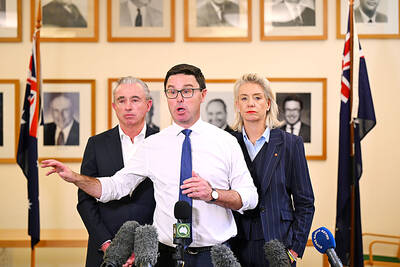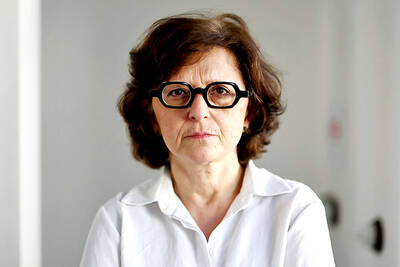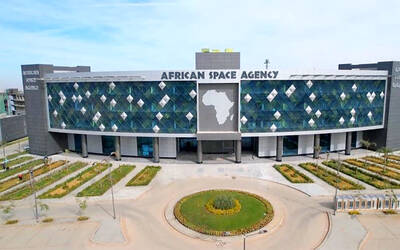Japanese Prime Minister Shinzo Abe and South Korean Prime Minister Lee Nak-yon yesterday agreed that they must work to ease the feud between the two neighbors that has spilled over into trade and security after their highest-level meeting in more than a year.
Both sides issued statements expressing a desire to repair ties after an about 20-minute meeting between the two leaders.
Lee delivered a letter to Abe from South Korean President Moon Jae-in that, according to Yonhap news agency, described Japan as a valuable partner in securing a lasting peace with North Korea and urged efforts to resolve their disputes.
“It’s important that relations must not be left in their current state,” Abe told Lee, describing them as “very severe,” according to a statement from the Japanese Ministry of Foreign Affairs.
Lee urged Abe to continue communications and exchanges, the South Korean Ministry of Foreign Affairs said separately.
The meeting is the most positive signal since South Korean courts last year issued a series of rulings backing the claims of people forced to work for Japanese companies during the country’s occupation of the Korean Peninsula from 1910 to 1945.
Japan has argued that all compensation claims were settled by a 1965 treaty that established ties between the two countries.
Moon has said the US-brokered agreement did not take into account the emotional suffering of the victims of Japan’s occupation.
The meeting helped set communications back to a more normal channel, but far more action was needed, said Kim Tai-ki, an economics professor at Dankook University near Seoul.
“With the key issue being trust, it will take much longer than top-level photo opportunities for it to actually rebuild,” he said.
Abe last met Moon in September last year and passed up a chance to meet him for formal talks during G20 events in June in Osaka, Japan. They are both expected to attend an ASEAN summit in Bangkok at the start of next month, which could afford them a chance for direct talks.
Economic worries in Japan and South Korea have mounted as they have both been in the fallout from a trade dispute between their major partners, the US and China.
Consumer spending in Japan is set to cool after Abe hiked the sales tax on Oct. 1 from 8 to 10 percent, while South Korea’s economy is on track for the smallest expansion since the global financial crisis as trade uncertainties weighed on investment.
Tensions have rapidly escalated, with Japan striking South Korea from a list of trusted export destinations and imposing restrictions on the sale of specialized materials essential to the country’s semiconductor and display manufacturing industries. South Korea responded by announcing its withdrawal from an intelligence-sharing pact, as its citizens boycotted Japanese goods and travel.
After largely sitting on the sidelines as tensions re-emerged, the administration of US President Donald Trump has over the past few months pushed the two sides to try to work out their differences. The US has been particularly critical of South Korea’s exit from the intelligence pact, as it is relying on cooperation between its two closest Asian allies to help counter China and North Korea.
As the meeting started in Tokyo, South Korean Minister of Foreign Affairs Kang Kyung-wha sent mixed signals by offering support for the discussions and cautioning Japan that it needs to withdraw its export curbs for ties to improve.
The pretext for Lee’s visit was his attendance at Japanese Emperor Naruhito’s enthronement ceremony on Tuesday.
Each country is the other’s third-largest trading partner and neither can afford a damaging economic fight as global growth cools.
South Korean exports are poised for an 11th monthly decline and semiconductor sales, which account for the largest share of exports, fell 29 percent in the first 20 days of this month, Korea Customs Service data showed.
The number of South Koreans visiting Japan last month dropped by about 58 percent from a year earlier, data showed.
“The current dismal situation does not benefit either country,” said Shin Kak-Soo, South Korea’s ambassador to Japan from 2011 to 2013.

BACKLASH: The National Party quit its decades-long partnership with the Liberal Party after their election loss to center-left Labor, which won a historic third term Australia’s National Party has split from its conservative coalition partner of more than 60 years, the Liberal Party, citing policy differences over renewable energy and after a resounding loss at a national election this month. “Its time to have a break,” Nationals leader David Littleproud told reporters yesterday. The split shows the pressure on Australia’s conservative parties after Prime Minister Anthony Albanese’s center-left Labor party won a historic second term in the May 3 election, powered by a voter backlash against US President Donald Trump’s policies. Under the long-standing partnership in state and federal politics, the Liberal and National coalition had shared power

CONTROVERSY: During the performance of Israel’s entrant Yuval Raphael’s song ‘New Day Will Rise,’ loud whistles were heard and two people tried to get on stage Austria’s JJ yesterday won the Eurovision Song Contest, with his operatic song Wasted Love triumphing at the world’s biggest live music television event. After votes from national juries around Europe and viewers from across the continent and beyond, JJ gave Austria its first victory since bearded drag performer Conchita Wurst’s 2014 triumph. After the nail-biting drama as the votes were revealed running into yesterday morning, Austria finished with 436 points, ahead of Israel — whose participation drew protests — on 357 and Estonia on 356. “Thank you to you, Europe, for making my dreams come true,” 24-year-old countertenor JJ, whose

A documentary whose main subject, 25-year-old photojournalist Fatima Hassouna, was killed in an Israeli airstrike in Gaza weeks before it premiered at Cannes stunned viewers into silence at the festival on Thursday. As the cinema lights came back on, filmmaker Sepideh Farsi held up an image of the young Palestinian woman killed with younger siblings on April 16, and encouraged the audience to stand up and clap to pay tribute. “To kill a child, to kill a photographer is unacceptable,” Farsi said. “There are still children to save. It must be done fast,” the exiled Iranian filmmaker added. With Israel

Africa has established the continent’s first space agency to boost Earth observation and data sharing at a time when a more hostile global context is limiting the availability of climate and weather information. The African Space Agency opened its doors last month under the umbrella of the African Union and is headquartered in Cairo. The new organization, which is still being set up and hiring people in key positions, is to coordinate existing national space programs. It aims to improve the continent’s space infrastructure by launching satellites, setting up weather stations and making sure data can be shared across